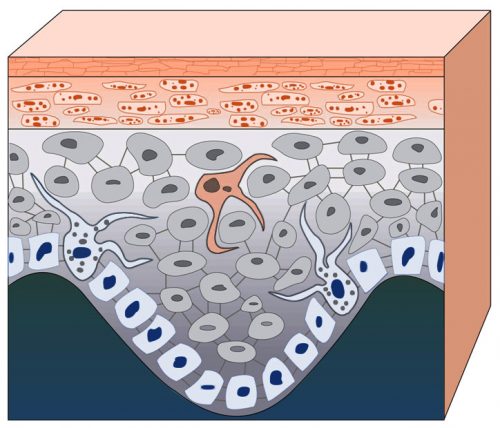Our skin is the largest organ of our body. It plays a number of important roles for our health. These include:-
- Acting as a protective barrier between the external environment and us.
- Retaining our body moisture
- Excreting wastes through our sweat
- Regulating our body temperature
- Formation of certain important chemicals such as vitamin
- Acting as an important sensory organ e.g. heat, pressure, pain.
The thickness of the skin is different in different parts of the body; with the thickest part being the heel and sole of our feet. The skin structure, in simple terms, can be divided into two large regions, the epidermis and the dermis. Both these layers have several smaller sub-layers.
EPIDERMIS
| The epidermis is the uppermost layer of the skin. It consists of several sub-layers. The bottom layer of the epidermis that is next to the dermis, is a wavy row of cells known as the basal layer. The most important role of the basal layer is to form new skin cells (keratinocytes, melanocytes, etc.) to replace the ones at the top that die. These dead cells are shed away at the topmost part of the epidermis. Except for the sole and the palm, the epidermis has three (3) sub-layers. The sole and palm have an additional layer. There are four main cell types in the epidermis. The most numerous (about 90%) are keratin-producing cells (keratinocytes). Keratin is the hard protein substance that protects us from the harsh environment outside. |  |
| The topmost two layers of the epidermis consist of dead keratinocytes that are flattened as they move upwards to the surface. Active keratinocytes are found below the dead layers. Melanocytes are cells that produce the skin pigment (melanin). They are located at the basal layer. They have tentacle-like projections that touch some of the keratinocytes. Melanin is transferred from the melanocytes to the keratinocytes by these tentacles. Two other cell types are found in the epidermis; one is a type of white blood cells that removes dead and foreign materials in the epidermis and the other is a type of nerve cell. As mentioned earlier, the top-most layers of the skin consist entirely of sheets of dead material, primarily keratin and melanin. The dead cells are held together by chemical bonds. These sheets are important because they act as shields from attack by various environmental factors. They also act to prevent valuable moisture from being lost to the environment. The topmost layer is regularly shed off and is replaced by another layer from the bottom. Similarly, the living cells of the epidermis are packed tightly together. They are also held firmly to one another by chemical bonds. The cells of the epidermis and dermis are also held together in the same manner. This gives the epidermis its firm support. | |
EXFOLIATION
As mentioned earlier, the dead cells at the topmost layer of the epidermis are continuously shed away to be replaced by the next layer of fresher cells. In cosmeceutical (skin care) science, this process is referred to as “exfoliation”. Exfoliation is a renewal process to ensure that the skin is constantly well protected and skin moisture is well maintained. As individuals, we can help our skin in its many important roles by using the right type of facial cleansers.
One of the key roles of cleansers is to make exfoliation more efficient. This is achieved through the addition of alpha-hydroxy acids (AHA) such as salicylic acid or beta-hydroxyacids (BHA), such as glycolic acid as ingredients in cleansers. These compounds are able to break the chemical bonds that hold skin cells together. By doing so, they loosen the cells (very similar to breaking down a brick wall by dissolving the cement that holds them together) which are then much easier to remove. The newer cells will make the face look fresher and cleaner. In addition, many of these dead cells also contain melanin, the dark skin pigment. By removing them it makes the skin look lighter and brighter. AHA and BHA’s penetrate well into the skin. They retain moisture and makes the skin firmer and fresher. Finally, AHA and BHA stimulates collagen production, thus making the face look younger and firmer in the longer term. In relation to acne formation, exfoliation decreases the opportunity for dead skin cells to fall into hair follicles. This in reduces clog formation, thereby resulting in less chances of whitehead and blackhead formation.